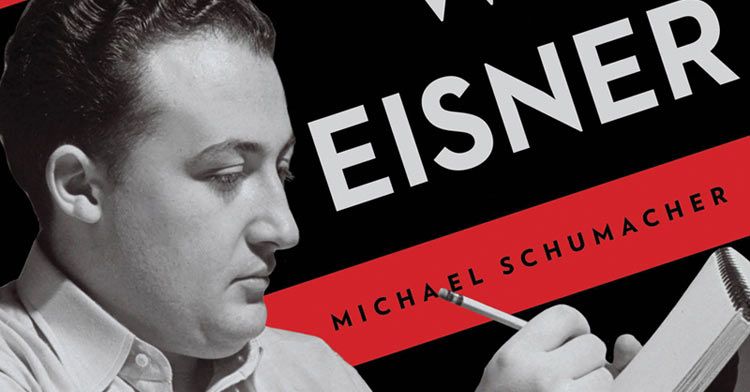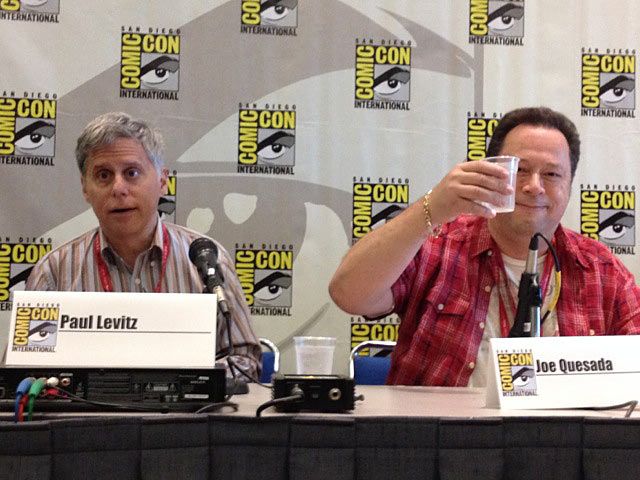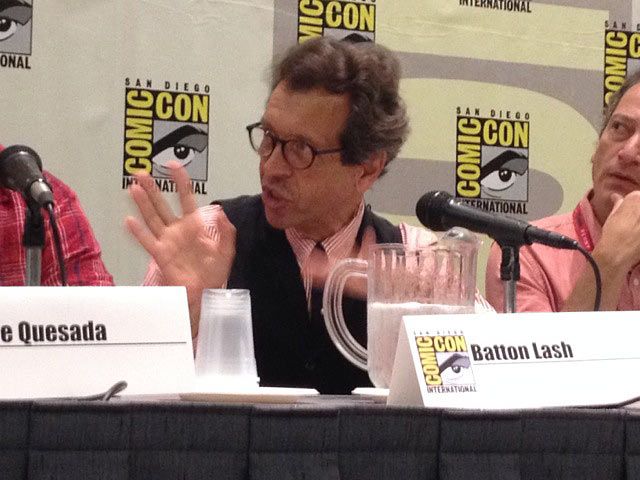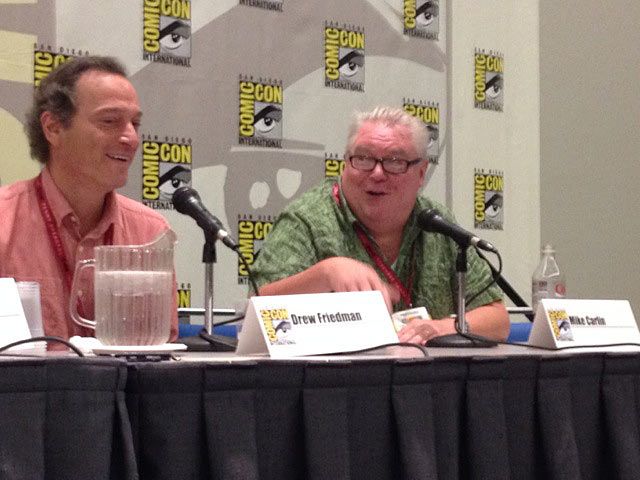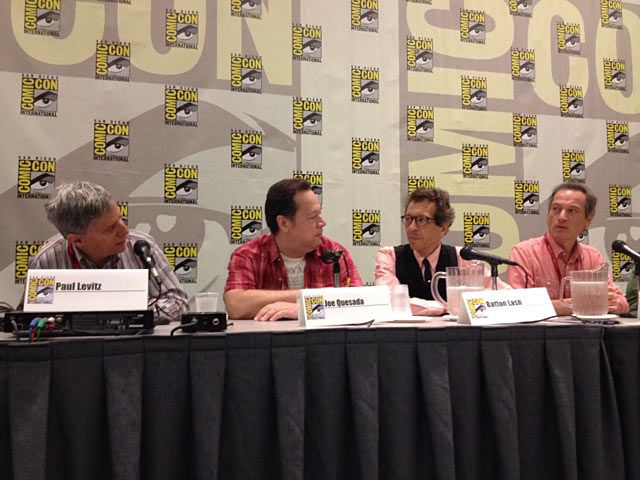"The challenge of teaching artists is probably at least three or four times the challenge of teaching normal human beings," joked Paul Levitz as he began the "Will Eisner: Teacher and Mentor" panel at Comic-Con International in San Diego.
The panel consisted of Will Eisner's former students from the New York School of Visual Arts where he taught for 20 years: Marvel Chief Creative Officer Joe Quesada, Batton Lash ("Supernatural Law"), Drew Friedman ("Old Jewish Comedians" & "Heroes of the Comics"), and DC Entertainment creative director Mike Carlin.
"First of all you're starting off with something that doesn't have a lot of objective fact, intrinsically. Second, artists are crazy," Levitz continued. "That's what makes them artists. That's what makes them wonderful. They see the world differently than everybody else."
Levitz then turned the floor over to Lash, whom he blamed for the panel's lineup. "I went to School of Visual Arts mainly to become a cartoonist because when I was a kid and there would be artists' bios in the letter pages, nine of ten artists would say 'and I attended the Cartoonist and Illustrator's School, now the School of Visual Arts.' I thought, 'This is the place to be,'" Lash said. "So I went there and attended and found out that they don't have cartooning classes anymore. It was kind of phased out in the late '60s.
"So in my first year, I made fast friends with John Holmstrom who was also a guy who wanted to break into comics and said, 'We should really put the pressure on SVA to start doing the cartooning classes again.' Of course, they were resistant. In those days, SVA was only two buildings. Now it's half of Manhattan. And it was a trade school. It wasn't accredited. Like you went there to learn a vocation and then you went on," Lash continued. "While we were there, it became accredited. It was very accessible. You could knock on the president's door and he'd call you in.
"We pitched him cartooning. 'We love comics, and we think we should have courses here.' He goes, 'I'll tell you what. If you can get at least thirty people to commit to taking this, we'll do it. But give us a wish list of who you would want to be your teachers.' So right away, Holmstrom and me and a few other people said 'Will Eisner and Harvey Kurtzman!' We'll try for the best, and we'll probably settle for Tony Tallarico."
RELATED: Dynamite Acquires Will Eisner's "The Spirit"
In two weeks, they were able to get the thirty students to commit to the classes. Lash described how the president casually walked into the student lounge and announced, "Oh, by the way, Will Eisner and Harvey Kurtzman signed on. They're going to be your teachers."
Levitz then wondered, "If you were asked that question now, and you were sitting there, who would you be asking for?" directing Mike Carlin to answer because of his experience managing talent.
"I went to SVA from 1976 to 1980. And thank you, Bat. Because I would not have gone to probably any college if I didn't have the chance to go where the cartooning teachers were," Carlin said. "This is gonna sound like bullshit, but I would put Drew Friedman on my list of teachers -- no, actually because I know Drew, I wouldn't. Maybe if there was a janitor opening," Carlin joked.
"Joe Quesada would certainly be on that list. I mean, just credentials of his own art career, but also his knowledge of the business would be invaluable to up and coming cartoonists. How many cartoonists live in New York anymore?" Carlin wondered aloud. "Klaus Janson would be on the list, and he's already a teacher at SVA currently. And I know they've had Walt Simonson as a teacher. These are the guys I'd put on the list."
Friedman shook his head. "Let me just say that I never would consider being a teacher because I might have a student like Drew Friedman," he joked. "People always say 'Drew was hard to teach because he went into SVA knowing what he wanted to do and left knowing what he wanted to do.'
"I loved being around those guys, just being in their presence. But, I was hard to make a dent in," Friedman continued. "I went in doing stipple work and Will didn't love that so much. He said 'You don't need to do that. You can just buy zip-a-tone. You don't have to waste time stippling. I'd think about it and go back to stippling. I was hard to teach. Also, you teach and maybe one or two students are gonna stand out, but the rest of them... you know. I don't think I could tolerate that. I would lose my temper a bit."
Despite being taught by Eisner, Carlin said, "I have never made my living as an artist or cartoonist. I've just been around cartoonists."
While there is overwhelming love for Eisner and his work today, Friedman there was a time when the writer/artist wasn't so beloved. "There were always a couple of guys who appreciated [him], who knew who he was -- Harvey Kurtzman, too -- who knew that we were in the midst of these legends. But the rest of the students were like 'Eh, they're just the cartooning teachers.'" Friedman said he wants someone to write a book about the '70s and '80s when Eisner, Kurtzman and Spiegelman all taught at SVA, "three legends teaching in this one little school on 23rd Street."
Quesada said he has thought often about teaching. that he has often thought about teaching. "The thing that's difficult for me when I start to think about teaching is actually formatting a curriculum, because that's one of my very very big weak points is actually formatting anything. I tend to do things very organically. I'm much better in Q and A form."
The artist and CCO said he usually conducts an open forum with Marvel's outgoing intern classes. "So much of what I do as an artist, I sometimes find hard to express unless someone asks me the question. If I have to put together a curriculum on how I construct a page, I might be able to do it, but it would take me so much time," Quesada said. "I've often thought about it. Maybe somewhere down the road I'd be able to do it, but with my current job it'd be impossible."
Levitz said teaching is "a nice semi-retirement thing," adding that developing language to explain art is a difficult task. "I used to be amazed watching Jack Kirby, because you could ask Jack to begin a drawing anywhere. 'Draw Captain America, but could you begin with his elbow?' It was as though there was a projector in his head putting the image on the table and Jack was able to start scribbling and build that out. Incomprehensible to me. And I could watch Joe Orlando, for many years when I was his assistant, build things out of circles and squares and make art out of that."
Levitz then asked the panel if the language Eisner and Kurtzman used helped them find the artist in themselves. "It did. Not just Will and Harvey. There were guys like Mike Mignola as well in my career that helped me," said Quesada. "Sometimes it's not even the way that they express how they do things in their language. Sometimes it's just watching them do it.
"I remember watching Mike Mignola, for example. He invited me up to his apartment to watch him draw one day, and it changed the way that I drew completely," Quesda continued. The next day I just made a 180 degree turn. Watching a professional work can be a mind altering experience. ...
Levitz prodded him for more about the abrupt turnaround. "I was drawing like Mike Mignola when I first broke into the comics industry. And when I met Mike, he said 'I know who you are. You dress up just like me.'" said Quesada. "Mike very graciously said, 'I like what you're doing, but if you're gonna draw like me, at least do it right!'" Mignola spent a few hours talking to Quesada about art and walking through his process. "It was like a fever dream. And the next day I went home, and I just started drawing, and it was no longer Mike Mignola. It was me."
"I did not go to SVA to be a cartoonist. I went to SVA to be an illustrator. I wanted to be Norman Rockwell. I took the cartooning classes just as electives. And in full disclosure, I failed Will Eisner's class," said Quesada.
Carlin joked, "Will would give you an 'A' if you showed up, and if you actually did work, he'd give you an A+."
The panel then moved to Eisner's technique with a brush, with Quesada explaining how reading about technique has no comparison to watching a master with his tools. "Along those lines, I remember in Will's class, everyone was having trouble with inking," Lash said. "At one point Will said, 'Just watch this. You're overworking everything.' So everyone huddled around. He just picks up this brush, whittles it with his tongue, and suddenly it was India ink magic right on the page. He just made it look so easy. Then we went back to overworking it."
Friedman pointed out the slideshow running beside the panel. "One of them is the cover of 'Gallery' magazine that I edited. Will did the cover image of the Spirit. He did it in front of the class. It took like three minutes. I watched him with the brush with his technique. It was just amazing. No pencil or anything. No sketch. And there it was: this beautiful piece of art. And I took it home and worked on the background for three weeks!"
Levitz asked about 'Gallery,' which was a student-produced magazine at SVA. Friedman said each class had its own magazine -- Kurtzman's class made "Kartoons," Eisner's made "Gallery." "I think it predated the sex magazine," he said.
According to Lash, when Eisner came to Visual Arts to speak with the thirty students who had signed up, he had already outlined his vision for the magazine. "He wanted to treat it like a shop, where certain students would do pencilling, inking, lettering, and the end of the semester the result would be this magazine." The plan turned out to be too ambitious, with Eisner not realizing how raw some students were, resulting in only one magazine produced per year.
"I just remember the key thing he said. 'Whatever you do for this magazine, you'll own it.' and that was a turning point, too" said Lash.
Levitz asked if Eisner, long a champion of artists owning their own work over work done for hire, had imparted that same philosophy to his students. "He was very particular about the artist being in charge of his own fate as far as the artwork, the writing. Doing it all yourself," Friedman said. "Will would teach an entire course on lettering. And he was very specific about it. 'Always draw your balloons first!'"
ECCC: All-Star Creators Explain "Why Eisner Matters"
Lash said, "You brought up something about how particular they could be. Will didn't like bridges between word balloons. 'Don't do that. Do two balloons, but no bridges.' Then in Harvey's class, 'You can connect these balloons with a bridge!'"
"They were opposites," Carlin said, nodding in agreement.
Asked if Eisner and Kurtzman ever come out, the panel resoundingly said no, with Lash and Friedman both saying they never saw them together, save for a convention appearance in 1974 which Lash said was also the first time he saw them either together or drunk.
"I'll draw that!" laughed Carlin. "It was funny. They both were down on the mainstream comics. That was something that they had in common." Friedman agreed, adding that Kurtzman in particular loved French and underground comics. He wouldn't bring in examples from Marvel or DC, but he would bring in guests such as Neil Adams who worked on superhero books.
Carlin said, "That was an amazing thing about both of those guys. They'd bring in these guest stars and they were people like Robert Crumb and Terry Gilliam."
"I took Will's class for three years and there was never a guest in the class," said Friedman. "It was just Will, which was great."
The talk of guests reminded Lash of one of his favorite quotes. "All the pros from Marvel and DC said 'There won't be any comics by 1980.' All of them were pretty much saying the same thing, because at this time, which was late 1973, 1974, there was a horrible paper shortage. Energy crisis. Thank God things have changed," Lash deadpanned.
"They were very down on it. After these guys would leave, Will would go, 'Look, I've seen this business die three times and there's something about the medium' and he'd launch into like an hour pep talk about the comics medium and how it would prevail," Lash continued. "The last time I saw Will, it was one of the industry's frequent [events] and he said to me, 'I've seen this industry die five times."
"Joe, you have an enormous amount of responsibility for the industry not dying in the last twenty years," said Levitz. "You didn't intend to do this. You wanted to go off and be Norman Rockwell. How important was that cheerleading? What's the difference that someone like Will makes in terms of telling people, 'This is gonna work, but you have to be a part of it'?"
Quesada paused a moment before replying. "It's so often, even to this day, I still hear people giving speeches about the demise of comic books. 'When is this incredible joyride that we're on going to be over? With all these great comic book movies out there, it's soon going to be over. It's going to be like the western.'
Levitz smiled and referred to "Guardians of the Galaxy." "You're really releasing this thing with the goddamn raccoon in it, right?"
"I've always had this incredibly positive feeling about everything," Quesada said. "Will was right. I can't imagine there was a worse time here than in the era of Fredric Wertham and 'Seduction of the Innocent' and those Senate hearings [that led to the formation of the Comics Code Authority]. It couldn't have been worse than that, and yet we survived. Will was absolutely right.
"People are going to be reading comics in one form or another, as long as the material is fantastic and wonderful and great to read," Quesada continued. "Right now, the quality of books that is being produced on an average level is better than any other time."
"We've had great moments, but overall there has not been a moment with the diversity and explosion of talent that we've got right now," Levitz agreed.
"Just look at the room downstairs!" said Carlin. "This whole convention has just grown with Will watching it. They're buying comics. They're buying things that have nothing to do with the past."
"I hear people lament 'I remember what San Diego was like twenty years ago when it was smaller,'" said Quesada. "Things are meant to change. I remember what San Diego was like during the '90s, when it was the collectors' boom, and there was a lot of money here. I wanted to take a shower. It felt terrible. The books weren't worthy of that acclaim. You know what, we're worthy of the acclaim now. And it'll be different twenty years from now, as well."
"Twenty years ago, this is what we wanted it to be. We wanted the world to take comics seriously," Carlin said.
"'Why are we in the ghetto? Why are we constantly in the ghetto?' Well, we're not in the ghetto," Quesada said. "And now we're sitting here going 'Well, we don't like this.' Comic book creators are in charge. We are behind the wheel. We're doing it. Let's be happy about that. I think Will would be happy with the state of the industry right now."
"Charles Bernstein had the best comment about Will and his passing. He said 'Will was the Moses of the comics world. He died before he saw the Promised Land,'" said Lash.
"Mike mentioned that most of the people downstairs are not interested in the past. The only reason I'm here is because my book ['Heroes of the Comics'] is all about the past," Friedman said.
"I wanted to ask you about that," said Levitz. "In the context of Will and the education. You came there with a style. You had some conflicts with Will along the way about that style. You chose not to do the same kind of work he did, both artistically and in terms of how you organized your career. And yet here we are thirty years later. You've chosen to do a major work focused on that world again. What creates that continuing fascination?"
"I just like drawing old Jews," joked Friedman. "I'm done with the comedians, and now it's the comic book artists."
Friedman spoke of how much he's always loved comics, starting with Marvel and DC. "I chose SVA because when I was looking through the catalog, I saw Harvey Kurtzman listed. I thought I was seeing things. I chose SVA because Harvey was there, and then realizing Eisner was there was just icing on the cake."
The topic then moved toward books, with Levitz mentioning part of Eisner's contribution to education was creating books about making comics. "I remember when I was a kid, I'd go to the library and they had two books about cartooning," said Carlin. "One of them was 'Sequential Art' and the other one was by Mort Walker. There was nothing else, and there wasn't going to be anything else for years and years. Now there's tons of stuff out there. But they invented it."
Asked by Levitz if anyone referenced Eisner's book to young cartoonists, Carlin said, "I would always talk about Will. I never threw the book at them, because the book was expensive. I wanted to keep my copy. I still have it. What was in those books, what I learned from that class was the storytelling part of things. Will was all about the storytelling and clarity and getting the information in there," said Carlin.
SDCC: Gaiman, McCloud, Smith & Kitchen Talk Eisner & the Graphic Novel
"He was one of the very few artists who had a philosophical set of theories about the art he was doing," Levitz said of Eisner as an educator. "You'd hear Will and Scott McCloud going back and forth about the importance of timing, the importance of a gutter, the difference between bridges and word balloons. There was a reason for everything in comics as Will saw it. That's part of what I believe made him a great teacher.
"Not to say that everybody sitting to my left would not have turned out to be wonderfully talented artists if they had never met Will, but I don't think that it's coincidental that you could line up a bunch of Will's students," Levitz continued. "We could have another dozen people, if we had a teleporter, who have gone on from those relatively few years of classes to be star talents in different fields of cartooning with us."
With that, the panel opened up the floor to questions from the audience. A question about the effectiveness of digital comics to capture new readers seemed to excite everyone on the panel. "How do you think digital delivery systems have helped in the appreciation of all that classic art and artists such as Will?" the fan asked.
"I think one of the best things about digital, first of all, is that it keeps stuff out there forever. But also, it adds a vibrancy to the material that makes it almost brand new again," said Quesada.
"That's what I was going to say," said Carlin. "At DC we used to get our comp bundle every week. They just switched us over so you're only getting it digitally at DC. I was like 'Oh my God, this is the worst.' I ran out and bought an iPad, which I didn't have before. And I have to tell you, it's like reading a comic in HDTV. It's amazing! And it's easy to carry around my whole collection."
"The other thing that's wonderful about digital is that for many years now, editors have been color correcting our books on computer screens," Quesada said. "We get these beautiful color files from these magnificent colorists and they're beautifully, fully painted. They come out in print, and they look great, but it's nothing like what we've seen on screen. Now you see exactly what we see."
"If I could try to channel Will a little bit, I think one of the things he very much believed in was that his art was about cartooning and storytelling," said Levitz. "It was about reaching people with telling the story through the pictures. Whatever the medium is was to do that. Cartooning was what mattered. I think he would be fascinated by what's going on."
"And if it wasn't happening, he would have been one of the first guys doing it," said Carlin. "'The Spirit' was not done the way any other comic strip was done. He invented something there. 'Contract with God' came out while we were in school at SVA. I remember because Will brought in a box and sold them to us."
"When you look at stuff like "The Spirit" and compare it to everything else that was coming out at that time, it was groundbreaking," Quesada said. "Just the way he was leading your eye through the page, what he was doing with typography; it was like nothing that was out there. It was revolutionary. So when you look at what's happening with the digital revolution, at Marvel we're constantly experimenting with different ways. We're taking our regular paper comics and delivering them in an interesting digital way, but we're also experimenting with direct to digital."
"We're doing this Infinite Comics technique which is, I think, a fascinating way of creating a comic book, which I think Will would have probably had a ball with. Because as a comic book artist and writer, you get to completely control the timing of not only the artwork, but the narrative as well. That's all part of the legend of Will and what he brought to comics. It's something he was a master of."
The last comment from the audience was a reference to the IDW Artist's Editions of "The Spirit," and how much could be learned from looking at his original art. "Can I toss in something about Will's originals? Because he would bring in his originals to the class. We'd see these giant pages and they looked great, but I'd notice there would be patches. Redrawn panels," said Lash. "I would say, 'Why did you redraw this?' And he goes, 'You know, I looked at it for the first time in twenty years and I knew I could do better.' This goes back to what Paul asked earlier: 'What did you get [from Will and SVA]?' And I do this now when I reprint my stuff. It's like, 'I could do a lot better.' What would Will do?"

